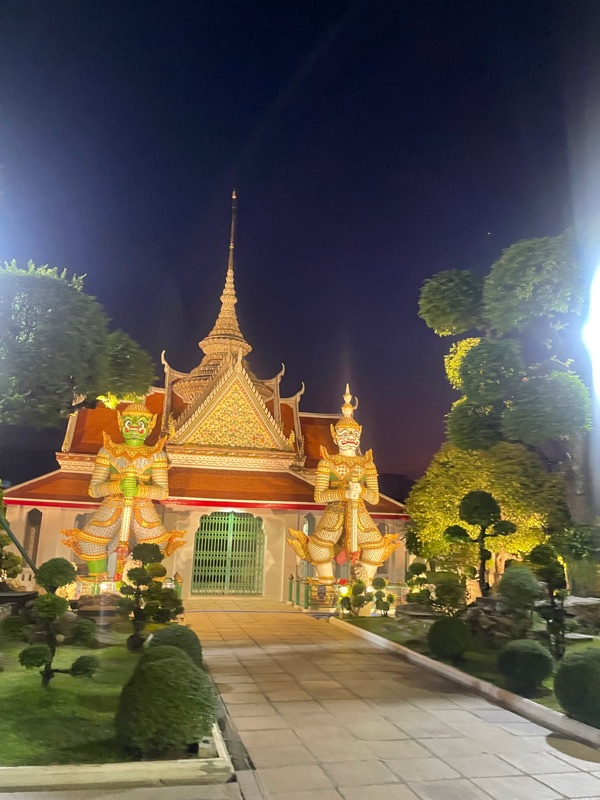Wat Arun: Temple of the Dawn — Bangkok Yai’s Shining Spirit on the Chao Phraya
By Around the World in a Rush

Wat Arun’s yaksha guardians: Thotsakan (green) and Sahasadecha (white) at the Ubosot gate.
Location: Wat Arun Ratchawararam Ratchawaramahawihan, 158 Thanon Wang Doem, Wat Arun, Bangkok Yai, Bangkok 10600, Thailand.
Why Wat Arun Matters
Rising on the west bank of the Chao Phraya, Wat Arun—the Temple of the Dawn—captures Thailand’s spiritual imagination with shimmering porcelain mosaics and a riverside silhouette that glows at sunrise and sunset. The complex blends Buddhist devotion with Khmer-inspired prang towers, telling stories of perseverance and renewal after the fall of Ayutthaya.
Quick Facts for Travelers
- District: Bangkok Yai (west bank)
- Hours: 8:00–18:00 (daily)
- Entry: ~100 THB (foreign visitors)
- Dress code: Shoulders and knees covered; remove shoes inside halls
- Getting there: Cross by ferry from Tha Tien Pier (near Wat Pho) for river views
Origins & History
Dating to the Ayutthaya era as Wat Makok, the temple gained its present name—Wat Arun, from Aruna, the Hindu god of dawn—when King Taksin arrived here at daybreak in 1768 while establishing Thonburi as his capital. Later monarchs of the Chakri dynasty restored and embellished the complex, creating today’s porcelain-clad prang ensemble.
Architecture in Plain Sight
The 70-meter central prang symbolizes Mount Meru, surrounded by four satellite towers for the guardians of the cardinal directions. The surface is inlaid with broken Chinese porcelain and shells—cargo remnants repurposed into luminous floral motifs that sparkle in changing light.
The Gate You Photographed: Yaksha Guardians
At the Ubosot (Ordination Hall) entrance stand two iconic yaksha giants: Thotsakan (green; Ramakien’s Ravana) and Sahasadecha (white). Their role is protective—holding clubs, warding off chaos, and reminding visitors that self-discipline guards the path to enlightenment.
Inside the Ubosot
The principal Buddha image—Phra Buddha Thammisornraj Lokathatdilok—is associated with King Rama II. Surrounding murals map the Buddhist cosmos and episodes from the Buddha’s life, creating a meditative atmosphere of balanced symmetry and color.
Best Times & Photo Tips
- Dawn: Soft tonal glow that justifies the temple’s name.
- Blue hour/night: Floodlit porcelain and mirrorlike paths (your photo look!).
- Angles: Centered symmetry at the yaksha gate; riverfront long shots; texture close-ups of porcelain rosettes.
Respectful Etiquette
Keep voices low, dress modestly, don’t point feet toward Buddha images, and step aside for worshippers. Drones require permission.
Bangkok Yai Neighborhood Notes
Pair Wat Arun with Wat Kalayanamit, the Artist’s House (Baan Silapin), and the river ferries. Snack on coconut ice cream and pandan sweets along the lanes.
Travel Gear Inspired by Wat Arun (Internal Links)
From our brand Around the World in a Rush, explore pieces inspired by rivers, light, and mosaic texture:
Practical Planning
- Cash & change: Small bills for ferries and drinks.
- Footwear: Easy on/off shoes for temple halls.
- Heat plan: Visit early/late; bring water and a hat.
Fun Detail
Wat Arun appears on Thailand’s 10-baht coin—a daily reminder of renewal after darkness.
📍 Google Map Pin
All Rights Reserved © Around the World in a Rush


0 Comments